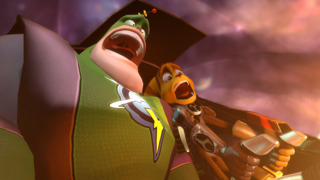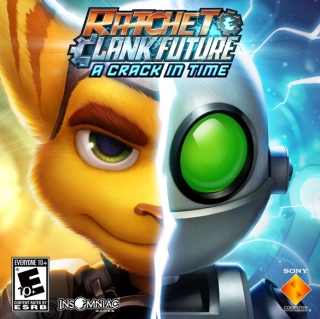Cracking over time
Back in the 2002 action platformer Ratchet and Clank, it was revealed that the lovable dorkbot Clank was created in a robot war machine factory. Clank got ejected from that place and wound up becoming BFFs with the furry toughguy Ratchet, and later thwarted Clank’s robot mechanical brothers to neatly wrap up that story arc. But developers Insomniac were jonesing to create an origin story that could span three games, where Clank has some kind of important fate within the grand scheme of the universe. (You know, because saving the universe 5 or 6 times wasn’t grand enough.) So they decided to piss all over their own canon and declare that Clank is really the destined watcher of the universe in their newest and presumably final installment in the series.

A Crack in Time is the finale to the Ratchet and Clank Future story arc, possibly the last for Ratchet and Clank in general. A candid interview with the truthful and humble Captain Qwark during the installation brings players up to speed as to what happened in the last two games. I was grateful seeing the interview in that it confirmed what I already suspected; nothing of note happened in Quest for Booty. Ratchet is scouring the galaxy looking for his backpack friend, and Clank is getting adept at his new job as the minimum wage Janitor of Time. This game ties up just about all of the loose ends left in the franchise; where Clank (really) came from, what happened to Ratchet’s family, where Clank got his laugh, and so forth. There’s nothing particularly sophisticated or shocking here – it’s a children’s game, after all, though you may be surprised as to how much you find yourself chuckling along. There’s an unsuspecting amount of good comedy to be found here, moreso even than previous games. Qwark is allowed to be Qwark, the pirate robots from Tools of Destruction get their own radio station, and villain-of-the-moment Dr Nefarious gives a gripping monologue about his motivations that’ll place him in the annals of supervillain history. So what I guess I’m to say is that series fans will be sated with this series conclusion.
(That said, I’ve got some issues, and they’re all spoilers, so you should skip this paragraph if you think spoilers make baby Jesus cry. The story is built around this plot device that going back in time could potentially destroy the universe. Yet Clank has no qualms creating two portals to the past, to alter what I would consider to be major events in galactic history. Or at least I think a planetary war is a major event in history. Another note; one of the missions involves Ratchet walking into a trap…but you find out that this upcoming mission is a trap from the loading screen text. Whoever wrote that loading screen, let alone the testers that ignored it, need to feel a flying monkey wrench to the gonads.)
The horizontally-divided boxart lets the player know that in A Crack in Time, both Ratchet and Clank will embark on separate adventures. In actuality, those adventures are divvied up 89% Lombax and 11% midgetbot. Clank’s sections involve smacking snails with a staff, deflecting the projectiles back at Phantom Gannon’s pet seahorses, and effortlessly clearing platforming sequences with the all-too-generous quadruple-jump. If making Clank feel like a miniscule sidekick was the goal of these missions, then good job boys. There are, however, some nice switch puzzle sequences, and I never thought I’d be saying “nice switch puzzle sequences” in 2010. Here, Clank must navigate a series of switches that open doors and raise platforms by way of recording video clones of himself, akin to the thankfully-forgotten Blinx the Timesweeper. These puzzles are the epitome of “just right.” They won’t shatter your brain in half, nor are the solutions apparent from the onset. The puzzles appear just frequently enough to be deemed a worthy Kit-Kat break from the main action, and not too often that they get as annoying as the Kit-Kat jingle. In fact, they appear just frequently enough that if I see them in another, competing video game, I’ll probably curse that game and sing the praises of Ratchet and Clank in its place.
And Clank also has some insignificant mini-game about scouring a globe,

shooting your deathray at key targets. This is somehow justified as “correcting the flow of time.” It is fortunate that this sequence only surfaces in one level, because I was fed up with this planetary maintenance sequence after the initial tutorial, let alone the 5 or 6 subsequent spherical sweeps.
The Clank stages seem to exist more as rest periods between entrees for the banquet hall party that is the Ratchet stages. The gameplay here will be plenty familiar to series vets – you run, you jump, you shoot. This is the last game franchise to still combine 3D mascot platforming mechanics with third person gunplay, and I’m starting to see the reasons why. Just about all of Ratchet’s combat sequences will consist of the player strafing and jumping over stray bullets while responding with large amounts of munitions. There really isn’t much of a tactical strategy in how you approach your enemies or what weapons to use, since you’re working on a limited ammo supply and will most likely deplete your pockets of rockets and shotgun shells quickly enough.
These games have always been more about the visual splendor and absurdity than the strategy, anyways. Throwing a disco ball in the air, watching those giant rancor monsters get crunk, then blasting them to pieces and collecting all the flying bolts that surface afterwards. You’ll recognize most of the weapons from Tools of Destruction, like the rocket launcher and the charismatic ball of energy that is Mr. Zircon. A few new toys, like the shotgun with an attached blowfish and a portal gun that summons tentacles from another dimension, highlight an underlying theme of animal cruelty.
But it’s hard to not feel a bit fatigued with the familiar gameplay. At the end of the day, you’re still strafe-shooting all of your adversaries in the same manner as when you first played Ratchet and Clank in 2002. All of the bosses are merely variations of “circle the goon and shoot.” And the game has a definite insecurity about its length that further draws out this flaw. You’ll repeat certain boss fights, sometimes in immediate succession of each other. The giant battlecruiser and the three-headed tank will quickly wear out their welcome. And there are plenty of sequences where Ratchet is trapped in a room, waiting for enemies to respawn and attack you, some of these being of questionable length. Oh, and there’s a few gun turret sequences. I can’t help but feel that any game released after Metal Gear Solid 4 shouldn’t even bother with gun turret sequences since they’ll only serve to be a step down, and the ones in A Crack in Time are especially underwhelming.
The central hub uniting all of the game sequences is, well, the universe itself, and Ratchet can fly around in his spaceship and engage in two-dimensional battles with enemy forces and…well they’re not particularly enthralling. You can land on these mini-planets and run through some smaller stages across the spherical surface, akin to Super Mario Galaxy. Except where that game made each planet a unique and creative sequence, A Crack in Time’s planet stages are reusing the same assets you encountered in the main stages. Thus, these stages feel repetitive, and do little more than remind you of a better video game. And you’ll more than likely have to play them anyways, because the game will abruptly halt your progress otherwise. You need to further Ratchet’s animal cruelty agenda by kidnapping these planets’ Zonis to upgrade your ship, as some stages will be blocked off otherwise. Artificial game lengthening, never a good thing. A Crack in Time is an 8 hour game with about 2 or 3 hours of that gameplay being unwanted filler.
If you’ve gone this far in the Ratchet and Clank Future series, then you may as well see it to the end and take a look at A Crack in Time. For what it’s worth, the story gives fans a satisfying conclusion and would perfectly bookend the series…not that I can imagine Sony putting this franchise to rest. Jak and Daxter recently made an unwanted comeback, after all. The curious newcomer to this series would be better served examining Tools of Destruction first.
3 ½ stars
